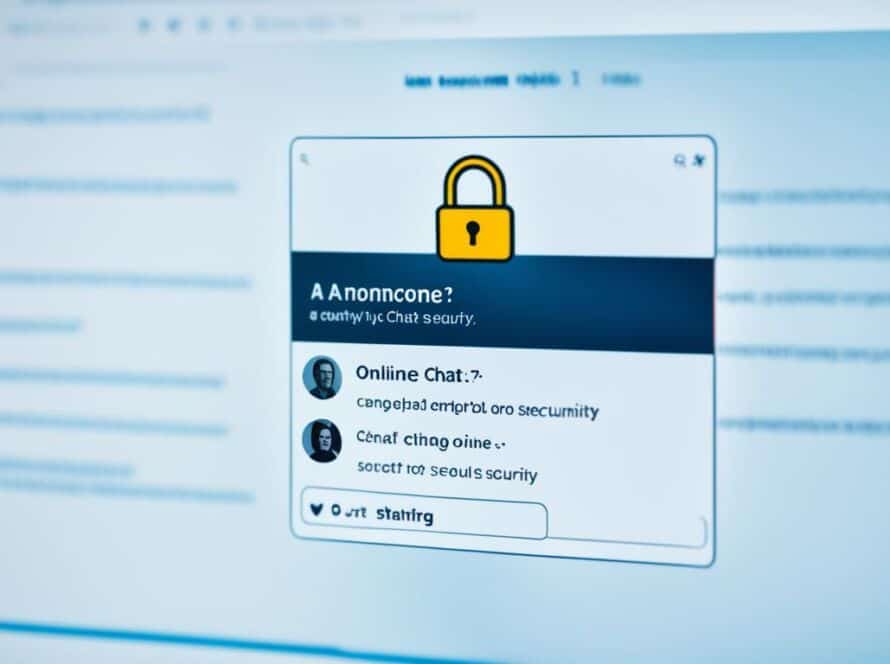Did you know that online communication has become an integral part of the teenage experience, with over 95% of American teens now having access to the internet? With such a profound impact on their social and emotional well-being, it is crucial to nurture the importance of safe teen chat rooms. These virtual spaces play a vital role in fostering growth, empowering young people to connect with their peers, and build meaningful relationships in a digital age.
However, the significance of safety cannot be understated. With the proliferation of online platforms, there are potential risks and challenges that need to be addressed to ensure a secure online environment for teenagers. In this article, we will explore the world of safe teen chat rooms, highlighting the benefits, risks, and strategies for maintaining online safety. Let’s delve into the world of nurturing growth and supporting positive online interactions for today’s teens.
Key Takeaways:
- Safe teen chat rooms are crucial in nurturing the growth and development of teenagers.
- Over 95% of American teens now have access to the internet, emphasizing the need for safe online spaces.
- In addition to benefits, there are potential risks associated with online chat rooms that must be addressed.
- Maintaining privacy, promoting responsible behavior, and empowering teens with knowledge on cybersecurity measures are essential for online safety.
- Parental guidance and control, open communication, and effective monitoring strategies are crucial for fostering a healthy online environment.
The Rise of Teen Chat Rooms: A New Era of Social Interaction
In today’s digital age, teen chat rooms have witnessed a remarkable surge in popularity, revolutionizing the way young people engage and communicate with one another. These virtual spaces have become the go-to platform for social interaction among teenagers, offering a unique and immersive experience that traditional offline forums simply cannot match.
Appeal of Virtual Spaces to Today’s Youth
Virtual spaces, such as online chat rooms, hold a strong appeal for today’s youth. These platforms provide a sense of freedom and anonymity, allowing teenagers to express themselves without the constraints they may feel in face-to-face conversations. In these virtual environments, teens can find like-minded individuals, share common interests, and build meaningful connections, transcending geographical boundaries.
Moreover, teen chat rooms provide an outlet for self-expression, enabling young people to explore their identities and discover new aspects of themselves. Through the use of avatars and virtual personas, teenagers can experiment with their personalities, fostering creativity and self-discovery in the process.
Shifts in Teen Communication: From Offline to Online Forums
The rise of teen chat rooms has marked a significant shift in how teenagers communicate with their peers. With the advent of advanced technology and widespread internet access, young people are now increasingly relying on online platforms as their primary means of social interaction.
Gone are the days of passing notes in school hallways or hanging out at local cafes; today’s teens navigate a digital landscape where instant messaging, video chats, and virtual hangouts have become the norm. This shift in communication preferences is largely attributed to the convenience, immediacy, and accessibility offered by teen chat rooms.
Furthermore, the rise of teen chat rooms has been fueled by the increasing integration of technology into teenagers’ daily lives. With smartphones and other internet-enabled devices becoming ubiquitous, young people have constant access to these virtual spaces, allowing them to connect and engage with their peers anytime, anywhere.
As the online landscape continues to evolve, it is crucial for parents, educators, and society as a whole to understand and adapt to these shifts in teen communication. By embracing these emerging virtual spaces and fostering a safe and supportive online environment, we can harness the potential of teen chat rooms to facilitate positive social interactions and empower young people to navigate the digital world responsibly.
Understanding the Risks: The Dark Side of Online Teen Chat Rooms
As much as online chat rooms provide a platform for teenagers to connect and engage with others, it is crucial to be aware of the potential risks lurking in these virtual spaces. The dark side of chat rooms encompasses various issues that can jeopardize the online safety of teens.
Cyberbullying is one of the prevalent risks that teenagers face in online chat rooms. It involves the use of technology to harass, intimidate, or humiliate others. The anonymous nature of chat rooms empowers cyberbullies to target their victims relentlessly, causing emotional distress and negatively impacting their mental well-being.
Online predators are another significant concern when it comes to teen chat rooms. These individuals manipulate the vulnerabilities of young users to exploit them for personal gain, including engaging in inappropriate conversations or even luring them into dangerous situations.
Protecting privacy is crucial in the online realm, and chat rooms may raise concerns about the exposure of personal information. With the open nature of these platforms, there is a risk of unintentionally sharing sensitive details that can be exploited by malicious individuals.
Lastly, the content shared in online chat rooms may not always be appropriate for teenagers. Exposure to explicit or harmful material can have a detrimental impact on their well-being, making it vital to establish boundaries and guidelines for their online interactions.
In order to ensure online safety for teens, it is important to raise awareness about these risks and equip them with strategies to protect themselves. This includes promoting responsible and respectful online behavior, encouraging open communication with trusted adults, and fostering a supportive community within online chat rooms.
By staying vigilant and informed, both teenagers and their guardians can navigate the dark side of chat rooms and create a safer online environment for everyone.
Teen Chat Online Safety: Securing the Digital Playground

Key Strategies for Maintaining Privacy and Security
When it comes to teen chat rooms, ensuring privacy and security is of utmost importance. Here are some key strategies to help maintain a safe online environment:
- Create strong and unique passwords for chat room accounts to prevent unauthorized access. Avoid using personal information or common words that are easy to guess.
- Use secure and reputable chat room platforms that prioritize user safety and have robust security measures in place. Look for platforms that employ encryption and have a team dedicated to monitoring and addressing security concerns.
- Enable parental controls and discuss the importance of using them with parents or guardians. These controls can help filter inappropriate content, manage screen time, and regulate chat room activities.
Empowering Teens with Knowledge on Cybersecurity Measures
In addition to implementing privacy and security strategies, it is crucial to empower teens with knowledge on cybersecurity measures to foster responsible digital behavior:
- Teach teens about the risks and consequences of sharing personal information online. Encourage them to be cautious about what they share with others in chat rooms and familiarize themselves with privacy settings.
- Explain the importance of avoiding suspicious links, downloading unfamiliar files, or interacting with strangers who may have malicious intentions.
- Encourage regular conversations about online safety and cybersecurity. Discuss common scams, phishing attempts, and strategies for identifying and reporting suspicious behavior.
By implementing these strategies and empowering teens with knowledge on cybersecurity measures, we can create a safer and more secure digital playground for teenagers to connect and interact.
Parental Guidance and Control in Online Environments
In today’s digital age, parental guidance and control play a crucial role in ensuring the internet safety of teens. Open communication between parents and teenagers is essential to establish a foundation of trust and understanding. By setting clear boundaries and implementing effective monitoring strategies, parents can help protect their children from the risks and dangers that exist online.
One important aspect of digital parenting is staying informed about the websites and apps that teens use. It is crucial to be aware of the platforms they interact with, the content they consume, and the people they communicate with. By having an open dialogue and discussing the potential risks, parents can guide their teenagers towards making responsible choices and developing critical thinking skills when navigating the online world.
Implementing parental controls on devices can also provide an added layer of protection. These controls allow parents to manage the amount of time their teens spend online, restrict access to certain websites or applications, and monitor their online activities. By utilizing these tools, parents can ensure that their children are engaging in age-appropriate and safe online experiences.
The Role of Education and Awareness
Education and awareness play a pivotal role in digital parenting. By staying informed about the latest online trends and potential risks, parents can equip themselves with the knowledge needed to guide their teenagers effectively. This includes understanding the importance of privacy settings, recognizing signs of cyberbullying or predatory behavior, and knowing how to respond to incidents effectively.
Additionally, parents can encourage their teens to participate in educational programs or workshops that focus on internet safety and responsible online behavior. These resources can provide valuable insights and strategies for navigating the digital world safely. By fostering open discussions and allowing their teenagers to share their experiences and concerns, parents can create a supportive and nurturing environment where teens feel comfortable seeking guidance and support.
Fostering a Healthy Online Environment
Creating a healthy online environment is not only the responsibility of parents but also of the entire community. By actively engaging in discussions about internet safety and encouraging positive online behavior, we can collectively promote a safe and supportive virtual space for teenagers.
It is important to emphasize the importance of empathy, respect, and consideration when communicating online. Teaching teenagers to think before they post, share thoughtful and constructive comments, and report any instances of cyberbullying or inappropriate behavior can contribute to a healthier online community.
Furthermore, parents can encourage their teens to engage in positive online activities, such as joining forums or platforms that promote creativity, learning, and personal development. By guiding their children towards these spaces, parents can help them cultivate a positive online presence and enhance their digital well-being.
In conclusion, parental guidance and control are essential in ensuring the internet safety of teens. By fostering open communication, setting boundaries, implementing effective monitoring strategies, and promoting education and awareness, parents can create a secure online environment for their teenagers. Together, we can empower our teens to make responsible choices, develop critical digital skills, and navigate the digital world with confidence.
Social VR and Teens: The Emotional Impact of Immersive Experiences
In today’s digital age, social virtual reality (VR) has transformed the way teens interact and engage with technology. With immersive experiences that merge the virtual and physical worlds, social VR offers unique opportunities for communication, exploration, and self-expression. However, alongside these benefits come challenges that must be addressed to safeguard the emotional well-being of teenagers.
Augmented Realities: Opportunities and Challenges for Teen Well-being
Augmented realities in social VR provide a new dimension of possibilities for teens. They can enter vibrant virtual worlds, connect with friends, and engage in collaborative activities. These experiences offer opportunities for creativity, personal growth, and even educational benefits. However, it is essential to be aware of the potential challenges that may impact teen well-being.
One of the challenges of augmented realities is the blurring of boundaries between the virtual and real worlds. Teenagers may find it difficult to distinguish between the two, leading to an emotional impact on their sense of identity and reality. Moreover, the highly immersive nature of social VR experiences can evoke strong emotions, both positive and negative, which can affect their overall well-being.
Additionally, the social aspect of social VR can present challenges for teens, as they navigate complex social dynamics and interactions within virtual communities. Cyberbullying, toxic behavior, and the pressure to conform to certain standards can all contribute to emotional distress.
Virtual Boundaries: Safeguarding Emotional Health in Social VR
To ensure the emotional well-being of teenagers in social VR environments, it is crucial to establish virtual boundaries. These boundaries can help protect their mental health and promote responsible use of technology. Here are some strategies for safeguarding emotional health in social VR:
- Encourage open communication: Create a safe space for teens to express their feelings and concerns about their social VR experiences. Encourage them to communicate openly with you, their peers, and any trusted moderators or administrators.
- Establish time limits: Set limits on the amount of time teens spend in social VR environments to prevent excessive immersion and potential negative effects on emotional well-being.
- Teach responsible virtual behavior: Educate teens about the importance of respectful and ethical behavior in virtual communities. Teach them about the consequences of their actions and the impact they can have on others.
- Monitor virtual interactions: Stay informed about the virtual interactions and relationships your teens are forming in social VR. Encourage them to report any negative experiences or instances of cyberbullying.
- Promote self-care: Emphasize the importance of self-care in both the virtual and real worlds. Encourage teens to take breaks, engage in offline activities, and prioritize their mental and emotional well-being.
By establishing virtual boundaries and promoting responsible use, parents, educators, and teenagers can work together to ensure the emotional well-being of teens in social VR environments. With thoughtful guidance and proper support, teens can navigate social VR experiences safely and benefit from the opportunities they offer.
Beyond the Screen: Addressing Cyberbullying and Building Resilience
In today’s digital age, cyberbullying has become a significant concern that deeply impacts the mental health and well-being of teenagers. It is essential to address this issue head-on and provide strategies to combat cyberbullying, promote resilience, and foster a supportive online environment. By raising awareness about the harmful effects of online harassment and equipping teens with the necessary tools, we can empower them to navigate the digital world with confidence.

Cyberbullying can take various forms, including hurtful messages, spreading rumors, public shaming, and even threats. Its consequences are far-reaching, often leading to negative mental health outcomes such as depression, anxiety, low self-esteem, and even suicidal thoughts.
To address cyberbullying effectively, it is crucial to educate both teenagers and parents about the signs, risks, and preventive measures. By encouraging open communication, fostering empathy, and promoting positive online behavior, we can actively create a safe space where teenagers can freely express themselves without fear of harassment or judgment.
Building resilience is another essential aspect of combating cyberbullying. By teaching teenagers how to cope with and bounce back from adversity, we can empower them to withstand the negative impact of online harassment. Encouraging self-care practices, promoting healthy relationships, and providing access to mental health resources can all contribute to building resilience and well-being in the face of cyberbullying.
Furthermore, fostering a supportive online environment is vital for addressing cyberbullying proactively. Online communities, social media platforms, and chat rooms should prioritize the establishment of strong community guidelines and codes of conduct. By implementing strict moderation practices, promptly addressing reports of cyberbullying, and promoting a culture of kindness and respect, we can create a safe digital space for teenagers to connect, share, and thrive.
It is important to equip teenagers and parents with practical tips and resources to deal with cyberbullying effectively. Educating teenagers on privacy settings, online etiquette, and responsible digital citizenship is crucial for their safety and well-being. Additionally, providing parents with guidance on monitoring their child’s online activities, recognizing warning signs, and seeking professional support when necessary can make a significant difference in addressing cyberbullying.
Together, let us take a stand against cyberbullying, build resilience in teenagers, and promote the mental health and well-being of all young people in the digital world. By creating a culture of empathy, respect, and support, we can ensure that online spaces are nurturing environments for growth, connection, and self-expression.
Cultivating Positive Communities: Role of Moderation in Teen Chat Rooms
In order to foster positive communities in teen chat rooms, moderation plays a crucial role. By implementing effective moderation practices, we can create safe and inclusive online environments for teenagers to connect and interact. Let’s explore the importance of community guidelines and a code of conduct in promoting respectful online interactions, as well as the various tools and techniques that can be utilized to ensure a safe chat room experience for teenagers.
The Importance of Community Guidelines and Code of Conduct
Community guidelines and a code of conduct serve as the foundation for establishing a positive and respectful online environment. These guidelines outline the expected behavior of participants and establish clear boundaries in terms of acceptable and unacceptable conduct. By setting these standards, we can cultivate an atmosphere of mutual respect, kindness, and inclusivity within teen chat rooms. The guidelines also help in addressing potential conflicts and ensuring that participants feel safe and comfortable while engaging in online discussions.
Moderation Tools and Techniques for a Safe Chat Room Experience
To ensure a safe chat room experience for teenagers, a range of moderation tools and techniques can be employed. These tools are designed to identify and address any inappropriate behavior, offensive language, or harmful content that may arise in the chat room. Moderators monitor conversations, enforce community guidelines, and have the authority to warn, mute, or ban users who violate these guidelines. They also have the power to remove any offensive or harmful content. By utilizing moderation tools effectively, we can create an environment that promotes positive engagement, discourages negative behavior, and safeguards the well-being of all participants.
In conclusion, moderation plays a crucial role in cultivating positive communities and ensuring a safe chat room experience for teenagers. By implementing community guidelines, a code of conduct, and utilizing moderation tools and techniques, we can foster an environment that encourages respectful communication, mutual support, and a sense of belonging. It is through these efforts that we can create online spaces where teenagers can freely express themselves, connect with others, and grow in a safe and nurturing digital landscape.
Education and Advocacy: Creating a Unified Front for Digital Safety
In today’s digital age, the safety of teenagers in online environments has become a top concern. To address this issue effectively, education and advocacy play a crucial role in creating a unified front for digital safety. By equipping educators, parents, and teenagers with the knowledge and resources they need, we can empower them to navigate the digital landscape responsibly.
Collaborative Efforts between Educators, Parents, and Teens
Building a safe online community requires collaborative efforts between educators, parents, and teenagers. Open dialogue and communication channels must be established to discuss the potential risks and challenges associated with digital platforms. By working together, we can promote responsible online behavior and ensure that teenagers have the necessary support and guidance to navigate the digital world safely.
Leveraging Research for Policy Changes and Awareness Campaigns
Research plays a vital role in driving policy changes and raising awareness about digital safety. By conducting extensive research in areas such as online behavior, cybersecurity, and the impact of technology on teenagers, we can identify gaps and develop evidence-based policies. Additionally, research can inform advocacy campaigns that highlight the importance of digital safety and foster a collective responsibility towards protecting teenagers online.
Collaboration, education, and advocacy are key pillars in creating a safe digital environment for teenagers. By working together and leveraging research, we can empower teenagers to make informed decisions, raise awareness about the importance of digital safety, and drive policy changes that prioritize the well-being of young people in online spaces.
Conclusion
In conclusion, ensuring the safety of teen chat rooms is of paramount importance in today’s digital age. This article has highlighted the key takeaways regarding the significance of creating secure online environments for teenagers.
By reiterating the importance of safe teen chat rooms, we emphasize the need to promote positive and responsible online behavior among teenagers. It is crucial for parents, educators, and teenagers themselves to be actively involved in creating a secure online environment.
The significance of online safety strategies cannot be understated. From understanding the risks associated with teen chat rooms to implementing privacy and security measures, this article has provided valuable insights on protecting teenagers from potential harm.
In summary, building a safe and nurturing online space for teenagers is a collective responsibility. By fostering open communication, educating teenagers about cybersecurity measures, and advocating for digital safety policies, we can create a unified front to protect young people in their online interactions on platforms like Musickraze.com and others. Let us prioritize the well-being of teenagers and ensure that their online experiences are positive, supportive, and secure.



